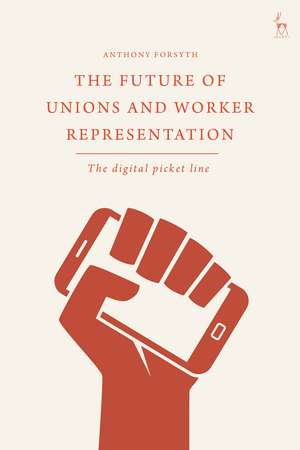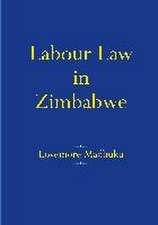The Future of Unions and Worker Representation: The Digital Picket Line
Autor Anthony Forsythen Limba Engleză Paperback – 14 iun 2023
| Toate formatele și edițiile | Preț | Express |
|---|---|---|
| Paperback (1) | 306.56 lei 6-8 săpt. | |
| Bloomsbury Publishing – 14 iun 2023 | 306.56 lei 6-8 săpt. | |
| Hardback (1) | 541.61 lei 6-8 săpt. | +117.28 lei 6-12 zile |
| Bloomsbury Publishing – 9 feb 2022 | 541.61 lei 6-8 săpt. | +117.28 lei 6-12 zile |
Preț: 306.56 lei
Preț vechi: 374.34 lei
-18% Nou
Puncte Express: 460
Preț estimativ în valută:
58.66€ • 62.73$ • 48.91£
58.66€ • 62.73$ • 48.91£
Carte tipărită la comandă
Livrare economică 18 aprilie-02 mai
Preluare comenzi: 021 569.72.76
Specificații
ISBN-13: 9781509956432
ISBN-10: 1509956433
Pagini: 368
Dimensiuni: 156 x 234 x 25 mm
Greutate: 0.44 kg
Editura: Bloomsbury Publishing
Colecția Hart Publishing
Locul publicării:London, United Kingdom
ISBN-10: 1509956433
Pagini: 368
Dimensiuni: 156 x 234 x 25 mm
Greutate: 0.44 kg
Editura: Bloomsbury Publishing
Colecția Hart Publishing
Locul publicării:London, United Kingdom
Caracteristici
Offers comparative approach to one of the most challenging questions in labour law today, drawing on examples from the UK, Australia, the USA, and Italy
Notă biografică
Anthony Forsyth is Professor of Workplace Law at RMIT University, Melbourne, Australia.
Cuprins
1. Introduction I. Unionising Big Tech II. Aims and Scope III. Why Compare the USA, the UK, Australia and Italy? IV. Chapter Overview V. The Digital Picket Line2. A Snapshot of Union Decline in the Four Countries I. Introduction II. Challenging Times for Trade Unions in the USA, the UK and Australia III. The Differing Trajectory of Union Membership and Worker Representation in Italy IV. Conclusion3. The Legal Framework for Unions and Worker Representation in the Four Countries I. Introduction II. The USA III. The UK IV. Australia V. Italy VI. Conclusion4. Unions in the USA: From the Organising Model to Alt-Labour I. Introduction II. The AFL-CIO Organising Model III. Change to Win IV. Unions Bypass the Broken NLRA Process V. Looking Further Afield: Unions in the Community, Alt-Labour and Bargaining for the Common Good VI. A (Seemingly) Lost Cause: Unions and Labour Law ReformVII. Conclusion 5. Australian Unions: From the Accord to 'Change the Rules' I. Introduction II. Early 1990s: The Legacy of the Accord III. Adopting the Organising ModelIV. Campaigning for Legal Change: Ending Work Choices and the Return of a Labor Government V. Unions on the Defensive again as the Coalition Returns to Government VI. Union Decline Intensifies, Spawning Exploration of New Membership Models VII. The 'Change the Rules' Campaign and its Aftermath VIII. Conclusion 6. Australian Unions: Innovations, Amalgamations and Organising Beyond the Workplace I. Introduction II. New Union Models and Digital Prototypes III. Back to the Future: A New Wave of Union Mergers IV. Campaigning and Organising Beyond the Workplace V. Conclusion 7. The UK: From 'New Unionism' to Indy and Digital Unions I. Introduction II. The UK Variant of Organising III. 'Third Way' Unionism: The Partnership Agenda IV. Back into the Wilderness: Unions Confront Austerity, Brexit and the Legacy of New Labour V. Up for a Scrap: Social Movements, 'Indy Unions' and #McStrike VI. 'An Alternative to Simply not being Present': New Membership Models and Digital Experiments VII. Conclusion 8. Italian Unions: Fighting for the Marginalised I. Introduction II. Specialist Unions for Precarious Workers - And Challenging Agency Work III. Italian Unions and Migrant Workers IV. Building (Rank-and-File) Union Strength in the Logistics Sector V. Conclusion 9. Unions and the Gig Economy: Advocacy, Campaigning, Mobilising I. Introduction II. Overview of the Gig Economy in the Four Countries III. The Mirage of Liberating Work in the Gig Economy IV. Enter, the Unions . V. Exposing the Reality of Gig Work as a Basis for Advocacy, Campaigning and Mobilising VI. Conclusion10. Unions and the Gig Economy: Misclassification Test Cases and Collective Bargaining I. Introduction II. 'Litigating the Digital Platform Model': Legal Challenges to the Misclassification of Gig Workers III. 'Staying United to Reverse the Race to the Bottom': Collective Bargaining in the Gig Economy IV. Conclusion11. What is the Future of Unions and Worker Representation? What Changes are Needed in Labour Laws? I. Introduction II. A Pathway to Union Revitalisation III. Reforming Labour Law to Empower Workers and Unions to Win IV. Conclusion12. The COVID-19 Pandemic: The Undeniable Case for Unions I. Introduction II. Union Involvement in National Responses to the COVID-19 Emergency III. Income Protection IV. Protecting Workers' Safety V. Conclusion: Implications of the Pandemic for Trade Unions
Recenzii
This book provides an insightful synthesis of industrial activity abroad, and thoughtful potential solutions to reversing union woes.
Professor Forsyth makes this need for comprehensive and structural trade union action and policy measures strikingly evident. He does so in a well-written, enlightening, and stimulating book underpinned by a robust legal and industrial relation analysis. There is no doubt that The Future of Unions and Worker Representation will be a most valuable resource for academics, researchers, and students in labour law and industrial relations for many years to come.
The Future of Unions and Worker Representation: The Digital Picket Line is an important book which comes at a critical time for the union movement. To fulfil the promise of revitalisation, unions must forge lasting connections with the newest generations of workers who have grown up as digital natives. The book builds a convincing case for reform, both of external legal frameworks and of unions themselves. It also builds a compelling case through its analysis of union activity in the gig economy and during the pandemic of the continuing necessity of trade unions and their important place as agents of all working people.
Professor Forsyth makes this need for comprehensive and structural trade union action and policy measures strikingly evident. He does so in a well-written, enlightening, and stimulating book underpinned by a robust legal and industrial relation analysis. There is no doubt that The Future of Unions and Worker Representation will be a most valuable resource for academics, researchers, and students in labour law and industrial relations for many years to come.
The Future of Unions and Worker Representation: The Digital Picket Line is an important book which comes at a critical time for the union movement. To fulfil the promise of revitalisation, unions must forge lasting connections with the newest generations of workers who have grown up as digital natives. The book builds a convincing case for reform, both of external legal frameworks and of unions themselves. It also builds a compelling case through its analysis of union activity in the gig economy and during the pandemic of the continuing necessity of trade unions and their important place as agents of all working people.

















